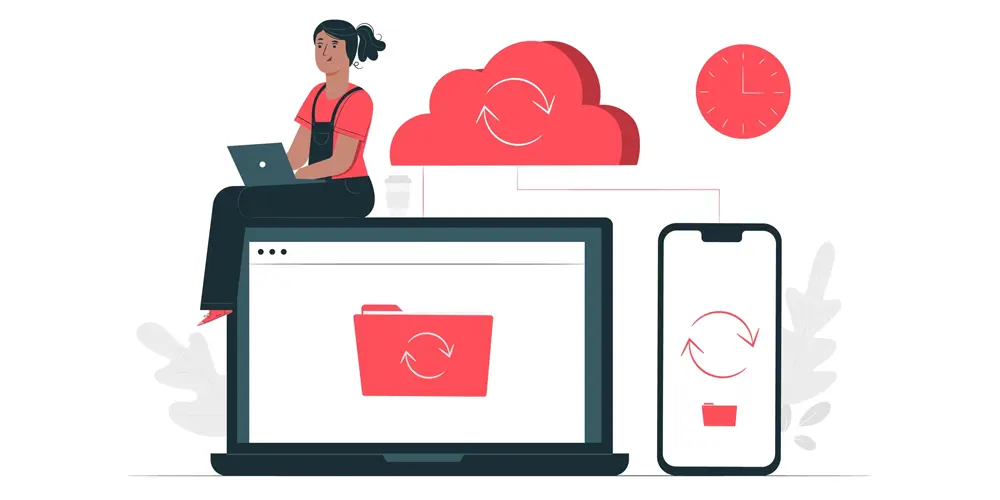7 Additional Important Components of a VoIP Carrier Network Explained
In our last blog, we covered 10 important components of a VoIP Carrier Network. However, that wasn’t the end of things. VoIP carrier networks are big and complex. Mere 10 components will not suffice to keep it running smoothly.
Additional components are needed to perform various other things such as ensuring failover and business continuity. There are also regulations and compliances a Carrier needs to adhere to in different countries.
In this article, we shall cover these additional but necessary components of a VoIP Carrier Network. Knowing and learning about these will further enable you to enhance your network.
Let’s dive straight into our list then!
1. Database Servers

Database servers are crucial components responsible for storing, managing, and providing access to various types of data essential for the network's operation.
Database servers store a wide range of data, including customer information, user profiles, call records, billing details, and configuration settings.
These servers also store user profiles, including authentication credentials, permissions, and preferences, ensuring secure and personalized access to VoIP services.
They maintain call records and logs, including call start and end times, call durations, participants, and call quality metrics. This data is crucial for billing, troubleshooting, and quality assessment.
Billing-related data, such as call rates, usage statistics, and customer invoices is also stored herein. This information is used to calculate charges accurately.
VoIP network settings, such as call routing rules, Quality of Service (QoS) parameters, and network policies, are stored and retrieved from database servers to ensure consistent and reliable service.
Voicemail messages and other messaging data are stored in databases. Users can thus access and manage their messages when needed. Database servers play a role in managing number portability. They ensure that customers can keep their phone numbers when switching carriers.
These servers often implement redundancy and backup mechanisms to ensure data integrity and availability, even in the event of hardware failures. Thus, database servers are critical to VoIP operations as they store all the important information.
2. Network Infrastructure

A VoIP carrier network relies on a variety of hardware components to ensure the delivery of high-quality voice and multimedia services. These components work together to support the network's operations.
Here's an explanation of the different hardware infrastructure components in a VoIP carrier network:
1. Media Gateways
Media gateways interface between traditional Public Switched Telephone Network (PSTN) systems and IP-based VoIP networks. They convert analog or digital voice signals into digital packets for transmission over the internet or IP network.
These gateways are essential for enabling VoIP calls to connect with traditional landline or mobile phones.
2. Signaling Gateways
Signaling gateways handle the conversion of signaling protocols between different networks, such as PSTN and VoIP. They ensure that call setup and teardown signals are properly translated and processed. Signaling gateways are critical for the interoperability of different communication systems.
3. Session Border Controllers (SBCs)
SBCs provide security, traffic management, and protocol translation for VoIP sessions. They protect the network from security threats, ensure quality of service, and facilitate seamless communication between different networks. SBCs are vital for maintaining network security and reliability in VoIP carrier networks.
4. VoIP Routers and Switches
VoIP routers and switches are specialized networking equipment designed to efficiently route and manage VoIP traffic within the carrier network. They prioritize voice packets to minimize latency and jitter. These devices optimize the flow of VoIP traffic and ensure a smooth and high-quality communication experience.
5. Database Servers
Database servers store and manage customer data, call records, billing information, and network configurations. They are the data backbone of the carrier network, providing critical information for various network functions. We’ve already covered these servers in detail in the point above.
6. Redundant Servers and Load Balancers
Redundant servers and load balancers ensure network reliability and scalability. Redundancy prevents service interruptions, while load balancers distribute network traffic evenly to optimize performance. We will take a deeper dive into this topic in the very next section.
7. Firewalls and Security Devices
Firewalls and security devices protect the network from unauthorized access, intrusion attempts, and security threats. They safeguard the integrity and privacy of VoIP communication. Security devices are essential for maintaining the security and confidentiality of VoIP services.
8. Hardware for Power Backup and Redundancy
Power backup systems and redundant hardware components ensure uninterrupted operation of the carrier network in case of power outages or hardware failures. These components enhance the network's resilience and minimize service disruptions.
9. Physical Infrastructure
The physical infrastructure includes data centers, racks, cabling, cooling systems, and other facilities necessary for hosting and maintaining network equipment. A reliable physical infrastructure is essential to house and support the hardware components of the VoIP carrier network.
With that, we’re at the end of our list. There could be more components in this list but those wouldn’t be as critical as the ones listed above.
3. Redundancy and Failover Systems:

Redundancy and failover systems in a VoIP carrier network are crucial mechanisms designed to ensure high availability and uninterrupted service. Unexpected events can cause service disruptions and ensuring business continuity thus, becomes important.
These systems provide backup solutions and seamless transitions to maintain reliable communication services. We shall explore this topic in more detail now.
1. Redundancy
The saying “The more the merrier” not only holds true but is quite an advantage in the tech world. Redundancy involves duplicating critical components, systems, or infrastructure elements to create backups that can take over in case the primary components fail.
Redundancy can be applied to various network components, including servers, routers, switches, power supplies, and data centers.
These backup components ensure that services remain available even if a primary component fails. Thus, enhancing fault tolerance, and minimizing service interruptions caused by hardware failures.
2. Failover
Failover is the process of automatically switching to a backup system or component when the primary system encounters a failure or becomes unavailable.
Failover mechanisms are triggered by specific events, such as hardware failures, network congestion, or loss of connectivity.
Such systems ensure continuous service availability, minimizing downtime and disruptions. Failover should occur transparently to users, ensuring that ongoing calls or data sessions are not interrupted.
4. Monitoring and Management Tools:

Monitoring and management tools are software applications, hardware devices, and systems used to oversee, optimize, and control various aspects of the network's performance and operation.
These tools are critical for ensuring the reliability, quality, and security of VoIP services. Here are some common monitoring and management tools in a VoIP carrier network:
1. Network Monitoring Tools
Network monitoring tools continuously track the health and performance of network devices, such as routers, switches, and firewalls. They monitor bandwidth usage, packet loss, latency, and network congestion, helping administrators identify and resolve issues affecting VoIP call quality.
2. Quality of Service (QoS) Management Tools
QoS management tools enable administrators to prioritize and allocate network resources. This ensures that VoIP traffic receives the necessary bandwidth and minimal latency. These tools help maintain high call quality by ensuring that voice packets are not delayed or disrupted by other network traffic.
3. Call Detail Record (CDR) Analysis Tools
CDR analysis tools collect and analyze data related to VoIP calls, including call duration, participants, and quality metrics. They are used for billing, troubleshooting call quality issues, and gaining insights into call patterns and usage.
4. Security Information and Event Management (SIEM) Systems
SIEM systems collect and analyze security-related data and events across the network to identify and respond to security threats. They help protect VoIP services from attacks, such as denial-of-service (DoS) and intrusion attempts.
5. Voice Packet Capture and Analysis Tools
Packet capture and analysis tools capture and inspect VoIP packets to diagnose and troubleshoot call quality issues. These tools help identify and resolve problems such as jitter, packet loss, and codec-related issues.
6. Configuration Management Systems
Configuration management tools centralize the management of network device configurations. Ensuring consistency and compliance with network policies thus, becomes easy. They simplify device configuration tasks, reducing the risk of misconfigurations that can impact VoIP services.
7. Traffic Analysis and Reporting Tools
Traffic analysis and reporting tools provide insights into network traffic patterns. Carriers can thus make informed decisions about capacity planning and optimization. These tools assist in identifying trends, forecasting network growth, and optimizing network resources.
As you can see, monitoring and management tools in a VoIP carrier network play a pivotal role in ensuring network reliability, security, and performance.
5. Regulatory Compliance Tools:

Regulatory and compliance tools are resources and mechanisms used to ensure that the network and services adhere to legal and regulatory requirements.
These tools help carriers meet industry standards, government regulations, and licensing obligations while maintaining transparency and accountability.
Let’s understand these in a bit more detail.
1. Call Recording and Retention Systems
These systems record and store VoIP calls as required by regulatory authorities. They often include features for indexing, archiving, and retrieving call recordings. Carriers use these tools to comply with regulations related to call monitoring, data retention, and dispute resolution.
2. E911 (Enhanced 911) Services
E911 tools enable carriers to provide accurate caller location information to emergency services. They help ensure that emergency responders can quickly locate callers in need of assistance. Compliance with E911 regulations is essential to public safety and legal requirements.
3. Number Portability Management Systems
Number portability tools facilitate the transfer of phone numbers between carriers while complying with regulations. Customers can thus retain their numbers when switching providers. These tools support customer mobility and competition among carriers while adhering to regulatory mandates.
4. Compliance Reporting and Auditing Software
Compliance reporting and auditing tools automate the process of generating reports and conducting internal audits. This ensures that network operations and services align with regulatory standards. They help carriers demonstrate compliance to regulatory bodies and proactively address non-compliance issues.
5. Regulatory Monitoring and Alerting Systems
These systems continuously monitor changes in telecom regulations. They alert carriers regarding new compliance requirements or modifications to existing ones. These tools assist carriers in staying up-to-date with evolving regulatory landscapes and adapting their operations accordingly.
6. Data Privacy and Security Tools
Data privacy and security tools help carriers protect customer data and adhere to privacy regulations, such as GDPR. These tools mitigate the risk of data breaches and unauthorized access while ensuring compliance with privacy laws.
7. Compliance Training and Documentation Platforms
These platforms provide training materials and documentation to educate staff members about regulatory requirements and industry best practices. They help ensure that employees are knowledgeable about compliance obligations and can implement them effectively.
Not getting in trouble with the law is always desirable and these tools mentioned above help you do just that.
6. Customer Premises Equipment (CPE)

Customer Premises Equipment (CPE) refers to the hardware and devices located at the customer's location or premises. These CPE devices are essential for enabling customers to access and utilize VoIP services.
We shall dive deeper into these devices and understand what each does.
1. VoIP Phones
VoIP phones, also known as IP phones, are specialized devices designed for making VoIP calls. They connect directly to the customer's data network and use the internet to transmit voice calls.
VoIP phones are used by both residential and business customers to place and receive VoIP calls. They offer features like call forwarding, conferencing, and voicemail.
2. Analog Telephone Adapters (ATAs)
ATAs are devices that allow traditional analog phones to be used with VoIP services. They convert analog voice signals from standard phones into digital data that can be transmitted over the Internet. ATAs are useful for customers who want to retain their existing analog phones while adopting VoIP services.
3. Softphones
Softphones are software applications that run on computers, smartphones, or tablets, turning these devices into VoIP endpoints. Users can make calls using a microphone and speakers or a headset. Softphones are versatile and portable, making them ideal for remote workers, travelers, or individuals who prefer a software-based VoIP solution.
4. Voice Gateways
Voice gateways connect traditional TDM (Time-Division Multiplexing) phone systems, such as PBXs (Private Branch Exchanges), to a VoIP network. They facilitate the integration of legacy phone systems with VoIP services.
Voice gateways enable businesses to transition gradually to VoIP without replacing their existing phone infrastructure entirely.
5. Session Border Controllers (SBCs)
In some cases, SBCs may be installed on the customer's premises to provide security and protocol translation. They help protect the VoIP network from potential threats and ensure interoperability with the carrier's network.
SBCs are common in enterprise VoIP deployments, where security and network integration are critical. These are most commonly observed in Banking and Finance, Healthcare and Government.
6. Routers and Modems
Routers and modems are essential for establishing and maintaining an internet connection. They serve as the gateway between the customer's internal network and the wider internet, enabling VoIP traffic to flow to and from the carrier network.
These devices are part of the core infrastructure for accessing VoIP services and other internet-based applications.
7. Firewalls and Security Devices
Firewalls and security appliances protect the customer's network from security threats and unauthorized access, including potential VoIP-related vulnerabilities. Security appliances are vital for safeguarding VoIP services and data.
Customer premises equipment in a VoIP carrier network encompasses a range of hardware and software devices. These enable customers to connect to and use VoIP services. Together, they form the bridge between the customer's location and the VoIP carrier's network.
7. Interconnection Points

Interconnection points refer to the locations where different networks or service providers connect and exchange voice traffic. These points are critical for enabling VoIP calls to traverse various networks and reach their intended destinations.
We shall explore all the important interconnection points herein.
1. Public Switched Telephone Network (PSTN) Interconnects
These interconnection points connect the VoIP carrier network to the traditional PSTN. VoIP calls can then be routed to and received from landline and mobile phones. PSTN interconnects enable VoIP carriers to offer seamless communication with users on legacy phone systems.
2. Peering Points
Peering points are locations where different VoIP carriers or internet service providers (ISPs) interconnect their networks. They establish direct connections to exchange VoIP traffic efficiently. Peering points reduce latency and reduce the reliance on third-party networks, leading to improved call quality and reliability.
3. Internet Exchange Points (IXPs)
IXPs are physical locations where multiple internet service providers (ISPs) and networks connect to exchange data. VoIP carriers may use IXPs as interconnection points to connect to other carriers and networks.
IXPs offer cost-effective and high-speed connections, facilitating the exchange of VoIP traffic among multiple carriers.
4. Network-to-Network Interfaces (NNIs)
NNIs are direct connections established between VoIP carriers or network operators. They define the technical and business terms for exchanging traffic, such as call routing agreements and quality of service (QoS) parameters.
NNIs enable carriers to establish customized partnerships and exchange traffic efficiently while maintaining control over routing and quality.
5. SIP Trunking Providers
SIP (Session Initiation Protocol) trunking providers offer VoIP interconnection services that allow enterprises to connect their private VoIP networks to the public internet or other VoIP networks.
Businesses use SIP trunking to access external VoIP services, connect remote offices, and enable remote workers to communicate through the corporate VoIP network.
6. International Gateway Switches
These switches provide interconnection to international carriers and networks. This allows VoIP carriers to route calls to and receive calls from destinations around the world. International gateway switches are essential for global VoIP carriers to establish connections with carriers in different countries and regions.
7. Emergency Services Gateways
Emergency services gateways establish connections to local emergency services, such as 911 in the United States. They enable VoIP calls to reach emergency responders with accurate location information. Ensuring access to emergency services is a legal requirement and a critical aspect of VoIP service provision.
All in all, interconnection points in a VoIP carrier network serve as the interfaces where different networks, carriers, and service providers connect to exchange voice traffic.
Wrapping Up
A lot of components and technologies are working together backstage to orchestrate the symphony of global communication. Sitting in the middle of the global communication jigsaw puzzle are the VoIP Carriers and their networks.
I hope everything you learned today will help you improve your existing VoIP network or build one up if you’re just getting started.
We will be covering more such topics that will help VoIP Carriers become better at building and managing their VoIP Networks. Stay tuned for more!

















































































































